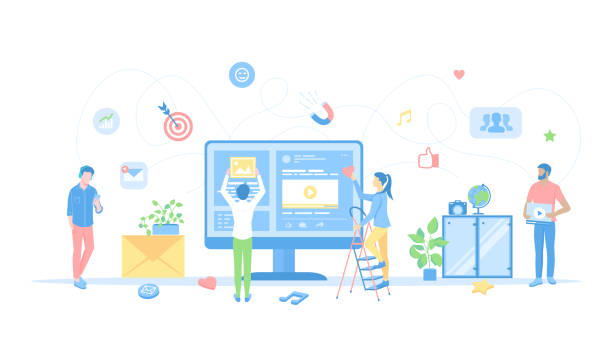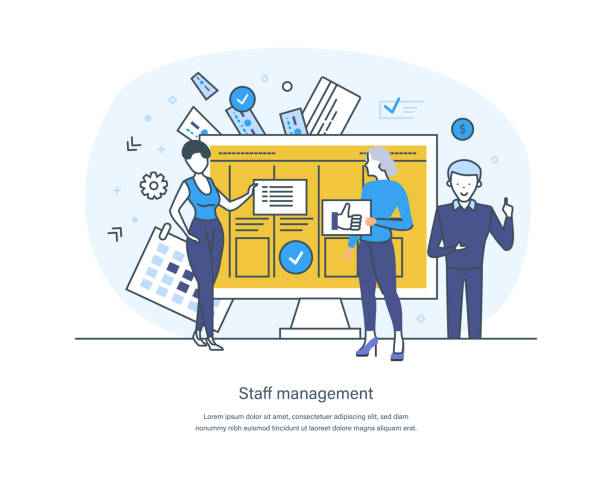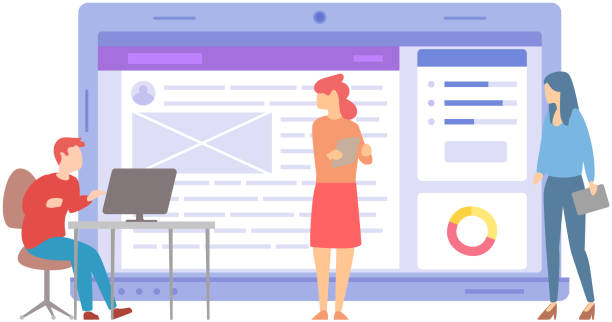An Introduction to the Importance of Secure Website Design in the Digital World

In the current era, where online activities have become an inseparable part of daily life, secure website design is no longer an option, but a vital necessity.
Websites are the beating heart of businesses, communication platforms, and countless information resources.
Therefore, #website_security, #user_data_protection, and #defense_against_cyber_attacks are of high importance.
Without a comprehensive approach to cybersecurity, websites become easy targets for cybercriminals who seek to steal sensitive data, damage reputation, or disrupt services.
This section explains the importance of a proactive approach to secure website design and the serious consequences of neglecting it.
Any vulnerability can lead to loss of user trust, heavy legal fines, and even business bankruptcy.
Therefore, adherence to secure website design standards from the earliest development stages is the most fundamental step towards online success and sustainability.
Do your e-commerce site visitors leave before making a purchase? Worry no more! With Rasaweb’s professional e-commerce website design services, permanently solve the problem of not converting visitors into customers!
✅ Significant increase in conversion rates and sales
✅ Unparalleled and engaging user experience
⚡ Contact us now for a free consultation!
Fundamental Principles and Pillars of Secure Website Design

To achieve a truly secure website, a set of fundamental principles and strong pillars must be observed.
These principles, which include specialized approaches and practical guidelines, form the core of any secure website design.
The first and perhaps most important pillar is the use of HTTPS protocol through the installation of an SSL/TLS certificate, which encrypts communications between the user and the server.
This action not only keeps information safe from eavesdropping but also significantly helps with SEO and user trust.
The second principle is enforcing strong password policies and encouraging users to use complex and unique passwords.
Regular maintenance and updates of systems, platforms (like CMS), and plugins are another vital part of secure web development, as many attacks occur through known vulnerabilities in outdated software.
Additionally, implementing secure coding principles such as validating inputs and outputs, using prepared statements for databases, and preventing code injection are considered specialized measures in secure website design.
Common Vulnerabilities and Prevention Methods

The web world is full of security threats, and to achieve secure website design, recognizing common vulnerabilities and their prevention methods is crucial.
This section analyzes some of the most common cyber attacks and provides educational solutions to counter them.
SQL Injection is one of the most common attacks that allows an attacker to inject malicious SQL code into the database.
To prevent it, Prepared Statements and strict input validation should be used.
XSS (Cross-Site Scripting) attacks also allow attackers to inject malicious scripts into users’ browsers; precise filtering of inputs and outputs is the fundamental solution.
CSRF (Cross-Site Request Forgery) enables the attacker to send forged requests on behalf of an authenticated user; using CSRF tokens is an effective solution.
Brute Force attacks, which involve guessing passwords, can be controlled by limiting the number of login attempts and using CAPTCHA.
Table 1: Common Vulnerabilities and Prevention Methods
| Vulnerability | Brief Description | Prevention Method |
|---|---|---|
| SQL Injection | Injecting malicious code into the database via user inputs. | Use of Prepared Statements and input validation. |
| Cross-Site Scripting (XSS) | Injecting malicious scripts into users’ browsers. | Filtering and escaping inputs and outputs. |
| Cross-Site Request Forgery (CSRF) | Forcing authenticated users to send unwanted requests. | Use of CSRF tokens (anti-forgery tokens). |
| Brute Force Attacks | Guessing passwords through repeated and automated attempts. | Limiting login attempts, Captcha, two-factor authentication. |
The Role of SSL/TLS Certificates in Website Security

In the discussion of secure website design, the critical importance of SSL/TLS certificates cannot be overlooked.
These certificates are the backbone of data encryption on the Internet, ensuring that information exchanged between the user and the website server remains secure and inaccessible to attackers.
From an explanatory perspective, SSL (Secure Sockets Layer) and its more advanced version TLS (Transport Layer Security) are protocols that, by creating a secure communication channel, prevent the theft of sensitive information such as passwords, bank card details, and personal data.
From a specialized perspective, the existence of these certificates not only enhances user credibility and trust but is also considered a positive ranking factor by search engines like Google, which helps improve website SEO.
There are various types of certificates, including DV (Domain Validation), OV (Organization Validation), and EV (Extended Validation), each offering a different level of validation and trust.
For any secure website development, proper installation and continuous updating of the SSL/TLS certificate is mandatory.
Is your e-commerce site ready to attract maximum customers and increase sales? Rasaweb, with its modern and efficient e-commerce website design, transforms your online business.
✅ Increased speed and improved SEO
✅ Excellent user experience on mobile and desktop⚡ Get a free e-commerce website design consultation from Rasaweb!
Data Protection and User Privacy

One of the biggest concerns for online users is the protection of their privacy and personal data.
In the field of secure website design, attention to this issue is of particular importance and directly affects the website’s credibility and success.
There are many guidelines in this area that help companies adopt appropriate data policies.
Implementing regulations such as GDPR in Europe or CCPA in California, indicates the necessity of adhering to high standards of data protection globally.
These laws emphasize that data collection, storage, and processing must be conducted with full transparency and informed user consent.
From a specialized perspective, encrypting data in transit and at rest, using strong hashing algorithms for passwords, and limiting access to sensitive information only to authorized individuals are among the key measures in secure website design.
Furthermore, a clear and accessible privacy policy, which informs users how their data is used, is essential for building trust and adhering to the principles of a secure website.
Continuous Updates and Security Maintenance

In the journey of secure website design, continuous maintenance and updates are just as important as initial development.
The cyber threat landscape is constantly evolving, and what is secure today may be vulnerable tomorrow.
This aspect of the topic is not just a practical guide but also includes news and developments related to newly discovered vulnerabilities.
Ensuring that all software used on the website, including the Content Management System (CMS), plugins, themes, and even the server’s operating system, is always up-to-date, is a vital measure.
Developers continuously release security patches to fix discovered bugs and vulnerabilities.
Ignoring these updates means leaving the doors open for attackers.
Furthermore, having a regular and automated backup plan for all website data and files is a core component of a website security strategy.
These backups not only allow for quick website recovery in case of malicious attacks but also in the event of human errors or hardware issues, ensuring stability in secure website design.
Advanced Tools and Technologies in Secure Website Design

To achieve high levels of secure website design, the use of advanced tools and technologies is essential.
This section introduces some of these specialized tools that can significantly enhance your website’s defensive capabilities.
WAF (Web Application Firewall) acts as a protective layer in front of the website, filtering incoming and outgoing traffic to identify and block malicious attacks such as SQL Injection and XSS.
CDN (Content Delivery Network) not only increases website loading speed but also improves the website’s resilience against DDoS (Distributed Denial of Service) attacks by distributing traffic across multiple servers.
Automated security scanner tools examine the website for vulnerabilities and weaknesses and provide detailed reports so you can address them before attackers do.
Additionally, the use of SIEM (Security Information and Event Management) systems for collecting and analyzing security logs can help identify suspicious patterns and ongoing attacks.
All of these are critical components of a comprehensive approach to secure website design.
Table 2: Advanced Web Security Tools and Their Applications
| Tool/Technology | Main Application | Security Benefit |
|---|---|---|
| WAF (Web Application Firewall) | Filtering HTTP/HTTPS traffic and blocking web attacks. | Protecting the website against injection and XSS attacks. |
| CDN (Content Delivery Network) | Distributing content on servers close to users. | Increasing resilience against DDoS attacks and improving speed. |
| Security Scanners | Automated website scanning to identify vulnerabilities. | Discovering security weaknesses before attackers. |
| SIEM (Security Information and Event Management) | Collecting, analyzing, and correlating security logs. | Early identification of attacks and incident response. |
Incident Response and Recovery

Even with the best secure website design approaches, the possibility of security incidents always exists.
Therefore, having a well-defined and comprehensive Incident Response Plan and recovery after them is essential.
This section provides practical guidance that can assist you in critical moments and prevent disastrous consequences.
The first step after discovering a security breach is to isolate infected systems to prevent further damage.
Then, by gathering evidence and performing a thorough analysis, the source and scope of the attack must be identified.
This stage involves reviewing logs, scanning systems for malware, and identifying attacker entry points.
After cleaning the systems and addressing vulnerabilities, it’s time to recover data from healthy backups and restore the website to normal operation.
At this stage, transparent and responsible communication with users about the security breach and actions taken is crucial for maintaining trust.
News experiences from major breaches show that speed and efficiency in incident response can make a big difference in the extent of damages and reputation recovery.
Secure website development does not end with prevention; it also includes preparedness for worst-case scenarios.
Does your current site showcase your brand’s credibility as it should? Or does it drive away potential customers?
Rasaweb, with years of experience in professional corporate website design, is your comprehensive solution.
✅ A modern, beautiful site tailored to your brand identity
✅ Significant increase in lead and new customer acquisition
⚡ Contact Rasaweb now for a free corporate website design consultation!
Educating and Raising Awareness for Users and Development Team

Often, the weakest link in the security chain is the human factor.
Therefore, within the framework of secure website design, continuous education and awareness not only for the development team but also for all website users, is of particular importance.
This section, with thought-provoking and educational content, aims to challenge misconceptions and strengthen security knowledge.
Do you know how effective Social Engineering attacks can be? Cybercriminals often try to obtain confidential information by deceiving individuals, rather than infiltrating complex systems.
Training the development team on secure coding methods, the importance of input validation, and avoiding insecure design patterns prevents many vulnerabilities.
On the other hand, educating users about phishing risks, the importance of using strong and unique passwords, and how to identify secure websites (e.g., by paying attention to the HTTPS sign) protects them from common threats.
A secure website requires a strong security culture that originates within the development team and extends to end-users.
The Future of Secure Website Design and Upcoming Challenges

While we strive to create secure website design, we must also take an analytical look at the future and emerging challenges.
This section examines future trends in cybersecurity and how they will impact secure website development.
Artificial Intelligence (AI) and Machine Learning (ML) are transforming security tools, but simultaneously, they are also being used by attackers to create more sophisticated attacks.
The emergence of quantum computing also poses a potential threat to current encryption algorithms, necessitating the development of post-quantum cryptographic protocols.
The expansion of the Internet of Things (IoT) and the connection of billions of devices to the network create new levels of vulnerabilities that can also impact website security.
Another challenge is maintaining the balance between security and user experience; an overly secure website might be inaccessible or annoying for users.
For this reason, secure website design in the future will require innovative and agile approaches to keep pace with evolving threats and still provide an engaging and efficient environment for users.
Frequently Asked Questions
| # | Question | Answer |
|---|---|---|
| 1 | What is secure website design? | The process of designing and developing websites that are resistant to cyber attacks and protect user data and privacy. |
| 2 | Why is website security important? | To prevent data breaches, financial losses, damage to company reputation, and maintain user trust. |
| 3 | What are some common website security threats? | SQL Injection, XSS (Cross-Site Scripting), CSRF (Cross-Site Request Forgery), weak authentication, and outdated software. |
| 4 | What are SSL/TLS and what is their role? | Protocols for encrypting data between the user’s browser and the website server, ensuring secure and private communication. |
| 5 | How can SQL Injection attacks be prevented? | By using Prepared Statements/Parameterized Queries, input validation, and ORMs (Object-Relational Mappers). |
| 6 | What is the role of a Web Application Firewall (WAF) in security? | A WAF monitors and filters HTTP traffic between a web application and the Internet to prevent malicious attacks. |
| 7 | Why are regular updates of software and libraries necessary? | Updates include patches for known security vulnerabilities that attackers can exploit. |
| 8 | How can XSS attacks be prevented? | By sanitizing and escaping all user inputs before displaying them on the web page and using Content Security Policy (CSP). |
| 9 | What does the Principle of Least Privilege mean? | It means that users and systems are granted only the minimum necessary permissions to perform their tasks, preventing unnecessary access to resources. |
| 10 | What is the importance of proper user session management? | To prevent session hijacking and unauthorized access to user accounts through secure and expiring session tokens. |
And other services of Rasaweb Advertising Agency in the field of advertising
Smart Data Analysis: Professional optimization to improve SEO ranking by optimizing key pages.
Smart UI/UX: Designed for businesses seeking digital branding through key page optimization.
Smart Brand Identity: A professional solution for user engagement focusing on custom programming.
Smart Direct Marketing: Revolutionize click-through rates with the help of attractive user interface design.
Smart Digital Branding: An innovative service for increasing user engagement through the use of real data.
And over a hundred other services in the field of internet advertising, advertising consultation, and organizational solutions
Internet Advertising | Advertising Strategy | Advertorials
Resources
Security in Website Design
Website Security Solutions
Important Tips for Increasing Website Security
Website Security and Ways to Increase It
? To reach the peaks of success in the online world and experience unparalleled sales, Rasaweb Afarin Digital Marketing Agency paves your way with its specialized services, including advanced e-commerce website design.
📍 Tehran, Mirdamad Street, next to Bank Markazi, Southern Kazeroon Alley, Ramin Alley, No. 6




